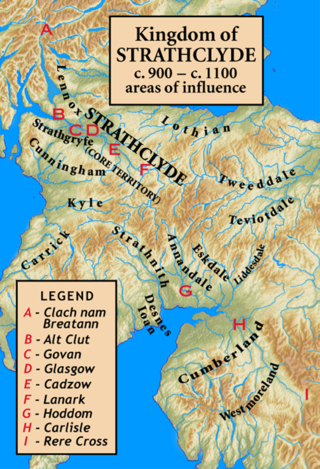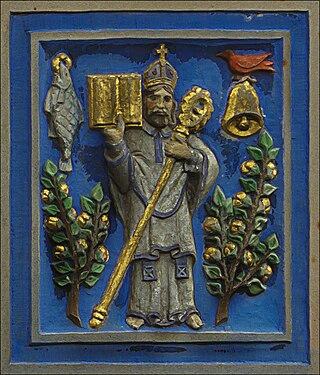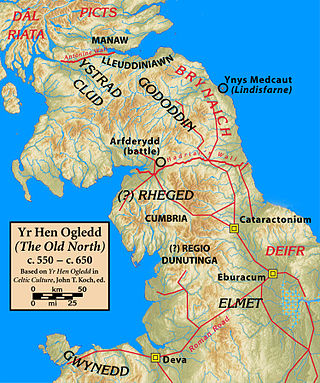
This is a list of saints associated with the kingdoms of the Hen Ogledd, including Elmet, Rheged, Gododin, Manaw, Lleuddiniawn and Ystrad Clud.

This is a list of saints associated with the kingdoms of the Hen Ogledd, including Elmet, Rheged, Gododin, Manaw, Lleuddiniawn and Ystrad Clud.

Saint Kentigern (also known as Saint Mungo) is said to have been the son of a princess of Gododdin, Taneu. He is believed to have died around 612 AD. [1] Taneu became pregnant after being raped by the King of Rheged, Owain mab Urien. Later in Kentigern's life, after his expulsion from Pictland, he was invited to live in Ystrad Clud (Strathclyde). From there it is believed he was one of the first saints to introduce Christianity to Scotland.
The mother of Saint Kentigern, Taneu was a 6th-century Brittonic princess of Gododdin in the 6th century. She was venerated in Medieval Scotland and Wales, especially in the Clwyd and Glasgow. Together with her son, Kentigern, they are the patron saints of Glasgow. She was said to have been thrown from the cliff of Traprain Law after her father discovered she was pregnant, following a rape by Owain mab Urien. She survived the fall and made her way to Culross, where she gave birth to Kentigern.
Saint Ke (or Kea) was a 5th-century saint born in Leuddiniawn (Lothian). He is said to be the son of King Leuddun of Lothian and that he served as a bishop in the Hen Ogledd before he moved to Wales and then to Cornwall. Later, he also travelled to Brittany. He is venerated in these locations. [2]

Saint Patrick lived in Britain in the 5th century. [3] At the age of 16 he was kidnapped by Irish pirates and spent nearly 6 years in Ireland until he escaped and returned to Britain. Later, he became ordained and returned to Ireland, where it is believed that he performed numerous miracles, such as ridding the snakes from Ireland – though this is thought to be an allegory for the subduing of paganism on the island. In some traditions he was born in Glannoventa, modern day Ravenglass in Cumbria, which was then part of the kingdom of Rheged.
Saint Oswald (c. 604 – 642) [4] and Saint Cuthbert (634/635 – 687) [5] as elements of personal names are recorded in many texts originating in the Hen Ogledd with the element 'gos', meaning 'servant of'. Gospatrick, Gosmungo, Gososwald and Goscuthbert [6] all appear as personal names in the 7th century. The form of 'gos' is unique to Cumbric.
In the White Book of Rhydderch there is a mention of a Gospatrick, in the Black Book of Carmarthen there is an alternate spelling, Gosparth.

Year 595 (DXCV) was a common year starting on Saturday of the Julian calendar. The denomination 595 for this year has been used since the early medieval period, when the Anno Domini calendar era became the prevalent method in Europe for naming years.

Strathclyde, was a Brittonic successor state of the Roman Empire and one of the early medieval kingdoms of the Britons, located in the region the Welsh tribes referred to as Yr Hen Ogledd, which comprised the Brythonic-speaking parts of what is now southern Scotland and northern England. The kingdom developed during Britain's post-Roman period. It is also known as Alt Clut, a Brittonic term for Dumbarton Castle, the medieval capital of the region. It may have had its origins with the Damnonii people of Ptolemy's Geography.
Modron ("mother") is a figure in Welsh tradition, known as the mother of the hero Mabon ap Modron. Both characters may have derived from earlier divine figures, in her case the Gaulish goddess Matrona. She may have been a prototype for Morgan le Fay from the Arthurian legend.
Taliesin was an early Brittonic poet of Sub-Roman Britain whose work has possibly survived in a Middle Welsh manuscript, the Book of Taliesin. Taliesin was a renowned bard who is believed to have sung at the courts of at least three kings.

Kentigern, known as Mungo, was a missionary in the Brittonic Kingdom of Strathclyde in the late sixth century, and the founder and patron saint of the city of Glasgow.
Bernicia was an Anglo-Saxon kingdom established by Anglian settlers of the 6th century in what is now southeastern Scotland and North East England.
Owain mab Urien was the son of Urien, king of Rheged c. 590, and fought with his father against the Angles of Bernicia. The historical figure of Owain became incorporated into the Arthurian cycle of legends where he is also known as Ywain, Yvain, Ewain or Uwain. In his legendary guise he is the main character in Chrétien de Troyes's Yvain, the Knight of the Lion and the Welsh Romance Owain, or the Lady of the Fountain, which corresponds to Chrétien's poem.

Elmet, sometimes Elmed or Elmete, was an independent Brittonic Celtic Cumbric speaking kingdom between about the 4th century and mid 7th century.

King Lot, also spelled Loth or Lott, is a British monarch in Arthurian legend. He was introduced in Geoffrey of Monmouth's chronicle Historia Regum Britanniae as King Arthur's brother-in-law, who serves as regent of Britain between the reigns of Uther Pendragon and Arthur. He has appeared regularly in works of chivalric romance, alternating between the roles of Arthur's enemy and ally, and is often depicted as the ruler of Lothian and either Norway or Orkney. His literary character is likely derived from hagiographical material concerning Saint Kentigern, which features Leudonus as king of Leudonia and father of Saint Teneu.

Y Gododdin is a medieval Welsh poem consisting of a series of elegies to the men of the Brittonic kingdom of Gododdin and its allies who, according to the conventional interpretation, died fighting the Angles of Deira and Bernicia at a place named Catraeth in about AD 600. It is traditionally ascribed to the bard Aneirin and survives only in one manuscript, the "Book of Aneirin".

Urien, often referred to as Urien Rheged or Uriens, was a late 6th-century king of Rheged, an early British kingdom of the Hen Ogledd of the House of Rheged. In Arthurian legend, he inspired the character of King Urien of either Garlot (Garloth) or Gore (Gorre). His most famous son, Owain mab Urien, similarly turned into the character of Ywain.
Morcant Bulc was a Brythonic prince, probably a king, from Northern Britain, during the period between the end of the Roman Empire and the establishment of an English state during the early Middle Ages.

Yr Hen Ogledd, or in English the Old North, is the historical region that was inhabited by the Brittonic people of sub-Roman Britain in the Early Middle Ages, now Northern England and the southern Scottish Lowlands, alongside the Celtic Kingdom of Elmet. Its population spoke a variety of the Brittonic language known as Cumbric which is closely related to, if not a dialect of Old Welsh. The people of Wales and the Hen Ogledd considered themselves to be one people, and both were referred to as Cymry ('fellow-countrymen') from the Brittonic word combrogi. The Hen Ogledd was distinct from the parts of North Britain inhabited by the Picts, Anglo-Saxons, and Scoti.
Dynod son of Pabo, better known as Dynod the Stout or Dynod Fawr was the ruler of a small kingdom in the North Pennines in the post-Roman Hen Ogledd. Regio Dunutinga was a minor kingdom or region in North Yorkshire mentioned in the Life of Wilfrid. P.N. Wood identifies this with the area of Craven.
Gwallog ap Lleenog was a hero of the Hen Ogledd. He has long been considered a probable sixth-century king of the sub-Roman state of Elmet in the Leeds area of modern Yorkshire, though some more recent scholarship would identify him more tentatively simply as a 'king of an unidentified region in the north'.

Teneu is a legendary Christian saint who was venerated in medieval Glasgow, Scotland. Traditionally she was a sixth-century Brittonic princess of the ancient kingdom of Gododdin and the mother of Saint Mungo, apostle to the Britons of Strathclyde and founder of the city of Glas Ghu (Glasgow). She and her son are regarded as the city's co-patrons, and Glasgow's St Enoch Square allegedly marks the site of a medieval chapel dedicated to her, built on or near her grave. She is commemorated annually on 18 July.
Clydno Eidyn was a ruler of Eidyn, the district around modern Edinburgh, in the 6th century. Eidyn was a district of the Gododdin kingdom in the Hen Ogledd, or "Old North", the Brittonic-speaking parts of Northern England and southern Scotland in the Early Middle Ages. Clydno became a figure in Welsh tradition.
Gweith Gwen Ystrat, is a late Old Welsh or Middle Welsh heroic poem found uniquely in the Book of Taliesin, where it forms part of the Canu Taliesin, a series of poems attributed to the 6th-century court poet of Rheged, Taliesin.

Aeron was a kingdom of the Brythonic-speaking Hen Ogledd, presumed to have been located in the region of the River Ayr in what is now southwestern Scotland. It existed during the post-Roman era, perhaps earlier, and disappeared before or during the 7th-century conquest of the region by the ascendant Kingdom of Northumbria.

The House of Rheged or the House of Rhun was an informal royal dynasty who ruled in the brittonic Kingdom of Rheged. The line is traced back to Coel Hen whose descendants are often referred to as the Coeling. The dynasty includes Urien, King of Rheged and his son Sir Ywain a Knight of the Round Table in Arthurian legend.